| Author |
Message |
J. Nicolaysen

|
 Posted: Sun 19 Jul, 2015 2:39 pm Post subject: Review of Main Gauche Dagger by Tomek Kowmal Posted: Sun 19 Jul, 2015 2:39 pm Post subject: Review of Main Gauche Dagger by Tomek Kowmal |
 |
|
A very recent notice of sale of a Main Gauche Dagger by Tomek Kowmal on a different forum caught my eye a few weeks ago. I hadn't heard of this smith before, but the pictures looked very nice. And I have a dagger addiction, a problem that I am sure a few of you can understand.
Main Gauche
The left handed parrying dagger is a form that I did not have represented in my collection. Beginning in the 16th century, a parrying dagger was used in the left hand as a defensive weapon as a rapier is used in the right. The term "Main Gauche" is French for "Left Hand." While some authorities such as G.C. Stone and Ewart Oakeshott used the term to narrowly describe the later ornate and flamboyant Spanish "Sail Guard" dagger type, with "Parrying Dagger" or "Left-Hand" used to describe all other types, "Main Gauche" can appropriately describe any dagger used in the left hand. This exact translation, rather than the conventional usage, is what the smith T. Kowmal has used to describe his dagger.
Smith Tomek Kowmal Ciupinski
Tomek, or Tom, is from Lodz, Poland. I do not know Tomek well, but his interest as a smith seems to be weapons of Poland, Prussia, Lithuania, and Russia. I hope to see more work from him in the future. His other work posted on his facebook page https://www.facebook.com/tomek.kowmal?fref=ts is quite nice, although there is not much yet. The main gauche and hussar sabre he has recently made have certainly made me more interested in a time period I do not know much about. I think that is a hallmark of a good maker; to not only appeal to those who know much about the smith's specialty, but to attract collectors to a completely new period or type of weapon. At this time, he is a new member of myArmoury and must fulfill the requirements of the "Industry Professionals" before posting more examples of his work.
The Dagger
Perhaps my first interest in this dagger was simply to fill a gap in my collection. However, the detailed engraving, wirework, and overall aesthetic made me confident that this would be a great example of the type and addition to my collection. At this time I prefer the side-ring guard type of parrying dagger to the ornate examples of the Spanish and Italian "Sail Guard" main gauche. Tomek says this example is of the 17th century, the blade shape is based on an original, and the designs and engraving are from other examples but not from any single example. The handle is comfortable and flat, and the finger-ring groove is a comfortable and natural fit. It is nicely weighted and a nice long blade inspires confidence for the purpose of the dagger. There is reach here for parrying, certainly. The blade edges are blunt, perhaps obviously, for parrying, but the point is narrow enough for a solid thrust to cause significant damage. The quillons are strongly welded; I wouldn't worry about a mishap in a duel.
The Scabbard
I asked Tomek for a scabbard for the dagger. Since I am uneducated in this period and type of weapon, I left it to his discretion, asking for a chape and some sort of suspension. He asked how much I would pay for the scabbard and what he produced exceeded my expectations for the design and quality by far, though he did not ask for any more money beyond what I initially pledged. As can be seen, several design elements are repeated from the dagger to the scabbard: wire-wrap, crosses, dots, and engraving. It is a wood-core, leather bound, steel chape and mouth scabbard. The whole effect of the scabbard is quite stunning. The suspension clip is possibly not period accurate, but solid and certainly effective. Again, the scabbard completely exceeded my simple idea and I couldn't be happier with it. It is clear Tomek put just as much pride and thoughtful design in the scabbard as the dagger itself. The time for him to make it was only an additional 10 days.
Finish and Specs
The dagger and scabbard are handmade. There are some rough marks or pitting on the steel, but this is not a concern for me given the price and the character of the weapon. The steel is clean and strong. The dagger clicks into the scabbard smoothly and securely; it will not fall out held upside-down. There are more marks than I expected from the pictures Tomek provided, but there are no flaws. The one obvious issue is a crooked seam on the brass brazing on the backside of the scabbard; this is a noticeable but minor aesthetic detail on a part that would not be visible hanging from a belt.
Tomek's specs are:
Overall length 485mm (19.09 inches)
Blade length 340mm (13.3 inches)
Weight 430g (15.16 ounces/ 0.94 pounds)
PoB 0mm
Edge 0,1mm
Use
In this section I would like to talk about historical use of this weapon type and my own use of the dagger. However, I am really too much of a neophyte in dual-handed fencing to even know how to hold the dagger in an efficient way. And it is a parrying dagger so it is not appropriate for cutting. However, if anyone would like to bring out some rapiers this way, we can have some fun. More seriously, if anyone would like to discuss usage of a left-hand dagger in fencing systems, or resources to learn about it, I would be grateful!
Transaction Details Sometimes this is a lesser aspect of a review, but in this case some praise is warranted. Contact with Tomek was made initially through private messaging, and then through email for the rest of the transaction. Our correspondence was a little rough because of my complete lack of Polish language skills and Tomek's use of Google Translate, but the gist was clear, sentences stayed short, and speaking for myself, I was not worried about misrepresentation or dire confusion. Payment was easy, through Paypal, and shipping took only five days. Packaging was excellent; the dagger arrived in a sturdy hollowed-out Styrofoam block with no chance for damage. The transaction was very easy, quick, and worry-free. From the time I first contacted Tomek about the dagger to the time it arrived with a freshly-made scabbard, from Poland to Wyoming, was only three weeks to the day.
Buy Again?
I would certainly buy more work from Tomek in the future if something he produced caught my eye. I am too uninformed about the 16th-18th century heyday of the Polish-Lithuanian Commonwealth and the weapons from there to work on a custom project. And I might be hesitant at this time to start a project without having a better grasp of Polish for me or English for him. But I think if I were asking for a replica or inspired piece based on an original that he can work from, the result would be excellent. In the meantime, I will certainly see what he produces on his own; perhaps another weapon will catch a hold of me as this fine dagger did. His recent Hussar Sabre also looks incredible and I encourage people interested in these weapons to look for it on his FB page.
Pictures
All pictures here were supplied by Tomek. I will post at least one in-hand pic in a later post.
 Attachment: 107.69 KB Attachment: 107.69 KB
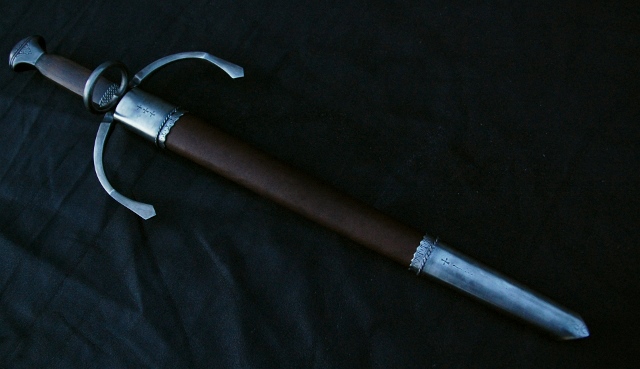
 Attachment: 94.06 KB Attachment: 94.06 KB
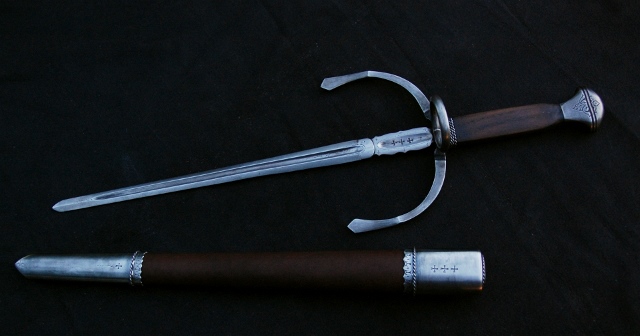
 Attachment: 122.39 KB Attachment: 122.39 KB
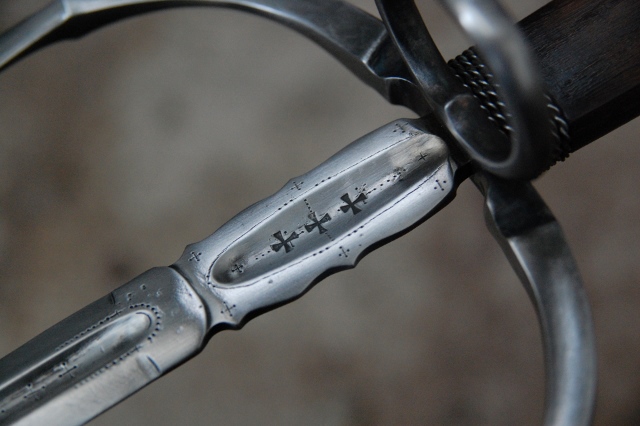
 Attachment: 172.66 KB Attachment: 172.66 KB
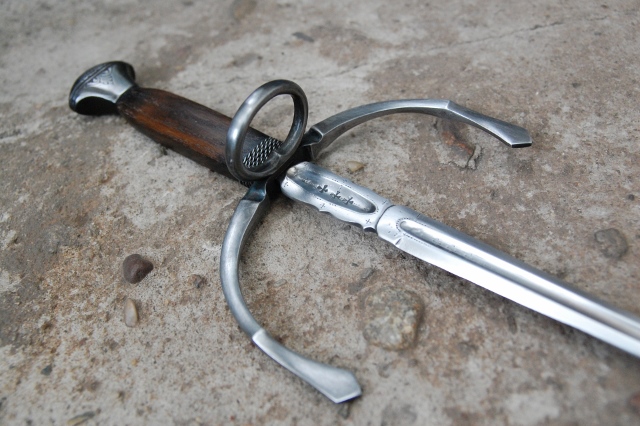
 Attachment: 113.97 KB Attachment: 113.97 KB
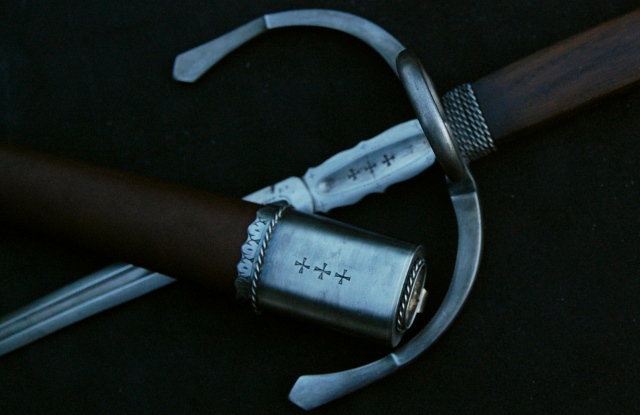
 Attachment: 86.15 KB Attachment: 86.15 KB
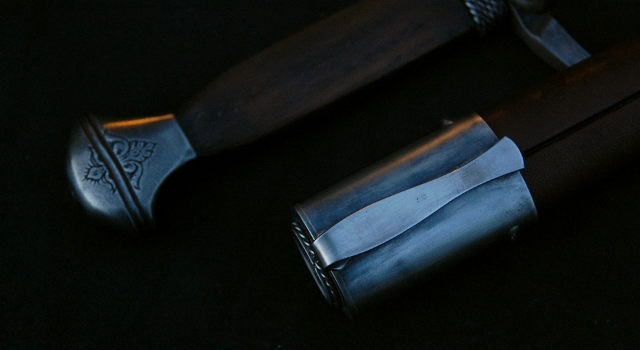
|
|
  |
 |
Aaron Hoard

|
 Posted: Sun 19 Jul, 2015 3:07 pm Post subject: Posted: Sun 19 Jul, 2015 3:07 pm Post subject: |
 |
|
|
Very nice piece and great review. Thanks for posting!
|
|
  |
 |
Lukasz Klimek

|
 Posted: Sat 25 Jul, 2015 1:54 pm Post subject: Review of Main Gauche Dagger by Tomek Kowmal Posted: Sat 25 Jul, 2015 1:54 pm Post subject: Review of Main Gauche Dagger by Tomek Kowmal |
 |
|
Hello Mr Nicolaysen,
Judging from pictures posted by Tomek, he's mainly interested in weapons of Polish-Lithuanian Commonwealth. I haven't noticed any prussian (german) or russian weapons. This Main Gauche stands in stark contrast to his other works. It's of western european origin. Definitely not polish.
|
|
  |
 |
J. Nicolaysen

|
 Posted: Mon 27 Jul, 2015 12:07 pm Post subject: Re: Review of Main Gauche Dagger by Tomek Kowmal Posted: Mon 27 Jul, 2015 12:07 pm Post subject: Re: Review of Main Gauche Dagger by Tomek Kowmal |
 |
|
| Lukasz Klimek wrote: | Hello Mr Nicolaysen,
Judging from pictures posted by Tomek, he's mainly interested in weapons of Polish-Lithuanian Commonwealth. I haven't noticed any prussian (german) or russian weapons. This Main Gauche stands in stark contrast to his other works. It's of western european origin. Definitely not polish. |
Hello Mr. Klimek,
Thank you for the clarification of his interests and work. I did not mean to imply a main gauche is a Polish weapon. I have only read of Western European examples, no Polish examples.
Tomek wrote me "At last time I was interested in the work of masters from Solingen from the fifteenth to sixteenth century and Italian masters and rapiers." As a contrast to his other work, all I can say is that he did a tremendous job. His szable that I have seen pictures of is very very well done.
| Aaron Hoard wrote: | | Very nice piece and great review. Thanks for posting! |
Thank you Aaron for reading. It was fun to try a review.
Here are a few more pictures, hastily taken with shadows, sorry.
 Attachment: 120.95 KB Attachment: 120.95 KB
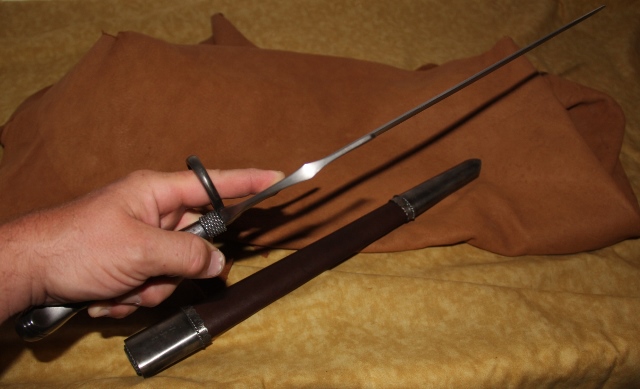
Side view in hand
 Attachment: 154.52 KB Attachment: 154.52 KB
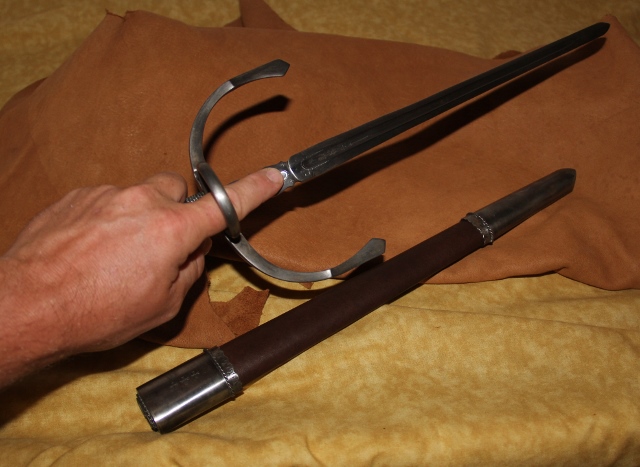
Top view in hand
 Attachment: 142.67 KB Attachment: 142.67 KB
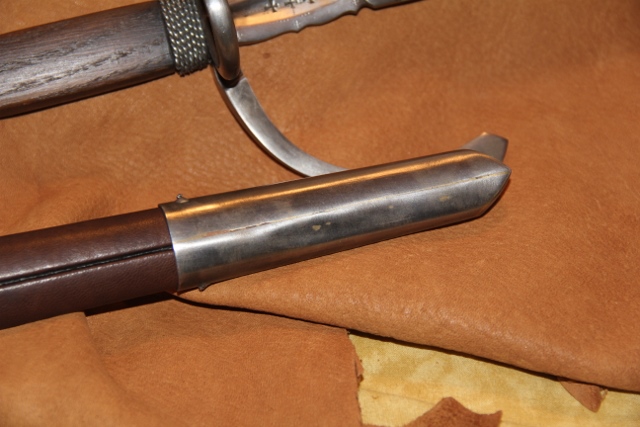
Braising irregularities, no big deal. Shows handmade character. Only "flaw" I could find!
 Attachment: 141.86 KB Attachment: 141.86 KB
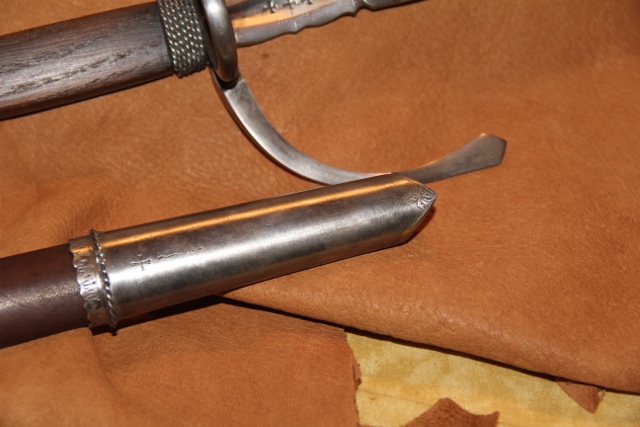
A fine thin brass line along bottom of chape, detail repeated elsewhere. Hard to see, but a very nice touch.
 Attachment: 135.05 KB Attachment: 135.05 KB
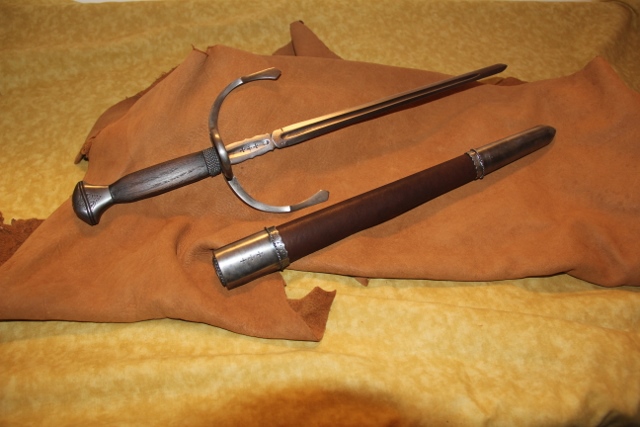
A great addition!
|
|
  |
 |
Jean Thibodeau

|
 Posted: Wed 29 Jul, 2015 10:14 pm Post subject: Re: Review of Main Gauche Dagger by Tomek Kowmal Posted: Wed 29 Jul, 2015 10:14 pm Post subject: Re: Review of Main Gauche Dagger by Tomek Kowmal |
 |
|
| J. Nicolaysen wrote: |
| Aaron Hoard wrote: | | Very nice piece and great review. Thanks for posting! |
Thank you Aaron for reading. It was fun to try a review.
Here are a few more pictures, hastily taken with shadows, sorry. |
Yes I agree that it's a very nice review, and the dagger itself looks very aesthetically pleasing.
One point I would make, and it's about the use and function of the " Finger Ring ": Well, one calls it a finger ring because it acts as a guard to the back of the hand preventing a parried blade from sliding along the flats of the dagger blade and hitting the back of the hand, or fingers.
The ring does the same thing as the Messer nagel, as a side guard.
http://www.albion-swords.com/swords/albion/ne...ark-II.htm
http://www.google.com/search?client=safari&am...p;tbm=isch
It is not a " Finger or a Thumb Ring ".
When I bought my first parrying dagger I made the same assumption with the ring, but thinking it was to protect the thumb instead of the finger as in your pic of your'e holding the dagger.
Now, from a functional point of view, your finger would be easily chopped off if you had your finger along the blade in this way, and the ring would do little more that be ideal for breaking your finger off should you receive a heavy blow on the dagger when parrying.
One could have the thumb on the other side of the blade from the ring on the ricasso, or on the middle of the guard, in the same way that one can have one's thumb on the side of the blade of a two handed sword when using some techniques.
I hope that this is useful information, and meant in a positive way, as I made the same mistaken assumptions when I bought an Arms & Armour Saxon Parrying Dagger some years ago, and it's a natural assumption if one isn't sure exactly why the ring guard is there for.   
http://www.arms-n-armor.com/dagg070.html
The ring guard on the parrying dagger serves the same function as the ring guard on this training rapier with a basic complex guard.
http://www.arms-n-armor.com/rapier239.html
You can easily give up your freedom. You have to fight hard to get it back!
|
|
  |
 |
Nathan Robinson
myArmoury Admin


|
 Posted: Wed 29 Jul, 2015 10:56 pm Post subject: Posted: Wed 29 Jul, 2015 10:56 pm Post subject: |
 |
|
You are not meant to stick your finger through that ring. That would be a very bad idea. The ring protects your fingers from being chopped off. Sticking the finger through that ring will only get your finger broken or cut. Some styles will have you placing your thumb on the ricasso at the back side of the blade opposite the side ring.
EDIT: I just realized Jean posted the same thing, but I'll leave this post here to restate the point.
.:. Visit my Collection Gallery :: View my Reading List :: View my Wish List :: See Pages I Like :: Find me on Facebook .:.
|
|
    |
 |
J. Nicolaysen

|
 Posted: Thu 30 Jul, 2015 4:31 am Post subject: Posted: Thu 30 Jul, 2015 4:31 am Post subject: |
 |
|
Thanks guys! I would have known if it were commonly referred to as a nagel, but finger-ring leads to that assumption I guess. It didn't seem like a very good grip but I figured that is what it is for.
Just goes to show the easy mistakes one can make when starting a new part of collecting weapons.
Thanks again Jean and Nathan.
|
|
  |
 |
Jean Thibodeau

|
 Posted: Thu 30 Jul, 2015 5:11 am Post subject: Posted: Thu 30 Jul, 2015 5:11 am Post subject: |
 |
|
| J. Nicolaysen wrote: | Thanks guys! I would have known if it were commonly referred to as a nagel, but finger-ring leads to that assumption I guess. It didn't seem like a very good grip but I figured that is what it is for.
Just goes to show the easy mistakes one can make when starting a new part of collecting weapons.
Thanks again Jean and Nathan. |
Oh, just to avoid confusion, the Nagel name is the specific to the Messer side stud or third guard, and I just mentioned it to better illustrate the similar function of the Ring on the Main Gauche which is a type of guard.
I'm not to sure what the Ring is called, but Side Ring or Side Ring Guard is at least descriptive.
Somewhere, some place a Victorian Era historian or museum label might have called these as Finger Rings or Thumb Rings creating a lot of confusion ? ( A ring is not always something that fits on a finger, but it's still a Ring .....  ) )
Basically the most important thing is understanding the function of the Ring whatever it's supposed to be called.
You can easily give up your freedom. You have to fight hard to get it back!
|
|
  |
 |
Nathan Robinson
myArmoury Admin


|
 Posted: Thu 30 Jul, 2015 7:27 am Post subject: Posted: Thu 30 Jul, 2015 7:27 am Post subject: |
 |
|
| Jean Thibodeau wrote: | | I'm not to sure what the Ring is called, but Side Ring or Side Ring Guard is at least descriptive. |
The ring would be called an anneau or side ring or front port.
| Quote: | | Somewhere, some place a Victorian Era historian or museum label might have called these as Finger Rings or Thumb Rings creating a lot of confusion ? |
I've never seen it called those things in publications. Thumb-rings would be on the opposite side of the hilt and going in a different direction intended to allow the thumb to grasp it. Likewise, finger rings are also going another direction (parallel to the blade) that allow a finger to pass through it.
You can get some insight from our "Anatomy of the Sword" article.
.:. Visit my Collection Gallery :: View my Reading List :: View my Wish List :: See Pages I Like :: Find me on Facebook .:.
|
|
    |
 |
J. Nicolaysen

|
 Posted: Thu 30 Jul, 2015 6:52 pm Post subject: Posted: Thu 30 Jul, 2015 6:52 pm Post subject: |
 |
|
OK, thank you both again. I didn't know the word "nagel" two years ago; now here are some better terms for this style then.

|
|
  |
 |
|
|
You cannot post new topics in this forum
You cannot reply to topics in this forum
You cannot edit your posts in this forum
You cannot delete your posts in this forum
You cannot vote in polls in this forum
You cannot attach files in this forum
You can download files in this forum
|
All contents © Copyright 2003-2025 myArmoury.com — All rights reserved
Discussion forums powered by phpBB © The phpBB Group
Switch to the Basic Low-bandwidth Version of the forum
|

